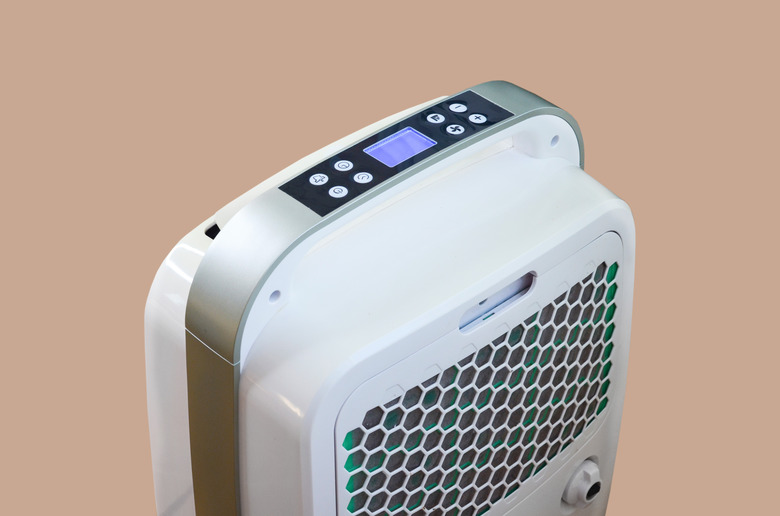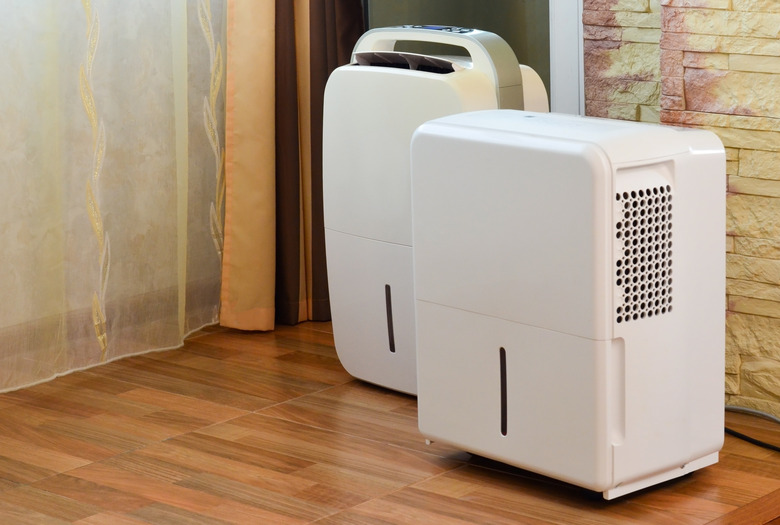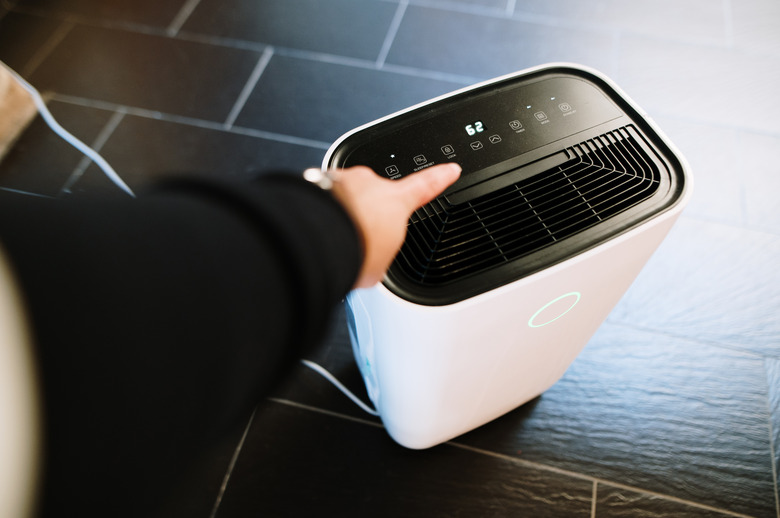How Does A Dehumidifier Work?
We may receive a commission on purchases made from links.
If you're wondering how a dehumidifier works, you can find everything you need to know by studying your window air conditioner — it employs pretty much the same principles. While air conditioners can technically dehumidify a room, standalone dehumidifiers do a better job and work in a different way — rather than blowing cold air, a dehumidifier blows warm air, thus solving high-humidity issues like mildew and mold growth, paint peeling, rot, and warping of wooden structures without making your space colder.
How Does a Dehumidifier Work? The Basics
How Does a Dehumidifier Work? The Basics
Some dehumidifiers use a desiccant to adsorb moisture (as in, accumulate moisture on its surface without actually absorbing it), but the most common ones are refrigerant, or compressor, dehumidifiers that employ a refrigeration system.
How Desiccant Dehumidifiers Work
The most common example of a desiccant dehumidifier is the package of silica gel crystals you can buy at some hardware stores to control humidity in a closet or drawer, but bigger units are available.
A desiccant dehumidifier consists of a spinning wheel composed of a desiccating material, such as charcoal, that adsorbs moisture from the air circulated past it by a fan. At the same time, a second fan directs air through a heating coil to the lower section of the wheel to dry it out and send the moist air in the opposite direction. This type of dehumidifier works well in low temperatures and is a better choice than a refrigeration dehumidifier for preventing water damage in crawl spaces and unheated basements.
How Refrigerant Dehumidifiers Work
Like an air conditioner or refrigerator, a refrigerant dehumidifier has a compressor. The compressor pressurizes a refrigerant (an inert substance with a low boiling point) to turn it into a liquid, a process that produces heat. The liquid refrigerant passes through a winding coil of metal tubing called the condenser coil, making the coil hot. The refrigerant then flows through a valve and into another coil — the evaporator coil — where it vaporizes, making this coil cold. The vapor then circulates back to the compressor where it is once again pressurized and turned into a liquid, and the cycle repeats.
While the refrigerant is circulating, a fan inside the dehumidifier pulls room air into the unit and over the cold evaporator coil, causing water vapor (humidity) in the air to condense into liquid water on the coil. The air then flows through the warm condenser coil, raising its temperature (so it is at room temperature or a little warmer) before it flows back into the room. The water on the evaporator coil drips down into a collection pan or tank, or it can be routed into a drain hose.
Types of Dehumidifiers
Types of Dehumidifiers
Dehumidifiers are available as portable units, window units, and whole-house units.
- A portable dehumidifier is usually mounted on casters and can easily be moved from room to room. Portable units can be plugged into any 120-volt outlet and are great for handling humidity problems in the basement, laundry room, or wherever they occur. Depending on the amount of water collected, they can be fitted with a drain hose that goes outdoors, or they can be emptied manually. Drainage is usually powered by gravity, but some models include a pump that can send the drainage upwards and out of a basement or other low-level area.
- A window-mount dehumidifier works like an air conditioner, and in fact, most window-mount dehumidifiers are basically air conditioners. If you want to cool the room, you can select the high cool mode, but if dehumidification is your priority, you can set the unit to low cool. Window-mount units typically draw more power than portable ones and may need a dedicated 240-volt circuit and receptacle. Water drips into a drip tray and drains outside.
- A whole-house dehumidifier typically works in conjunction with the home's HVAC system. It's mounted next to the heating/cooling system, and the air it processes is circulated by the blower through the home's existing ductwork. A whole-house dehumidifier must be installed by a licensed HVAC technician who will also hook the drain into the home's drain system.
Health Benefits of Dehumidifiers
Health Benefits of Dehumidifiers
By reducing excess moisture in the air, dehumidifiers reduce the risk of water damage to paint and exposed wood, and they have some very real health benefits as well. For one, low ambient humidity promotes the evaporation of perspiration and makes you feel more comfortable. This is a nontrivial boon for people who feel stuffy and claustrophobic in a high-humidity environment.
The main health benefit of dehumidifiers, however, is the reduction of pathogens and allergens responsible for such conditions as asthma, respiratory distress, and COPD. Mold, bacteria, and dust mites thrive in humid air, and their populations can be significantly reduced by maintaining the relative humidity lower than 65 percent, which a properly sized dehumidifier can easily do. Using a dehumidifier to lower humidity levels improves air quality and helps relieve such symptoms as coughing, wheezing, eye irritation, and chest pain.
How to Clean a Dehumidifier
How to Clean a Dehumidifier
To get the most benefit from your dehumidifier, it has to be clean. Otherwise. you'll be breathing all the dust, bacteria, and mold spores that get deposited from the ambient air on the filter and in the water reservoir. During periods of continuous use, you should clean your portable dehumidifier every three weeks. Unplug the unit and then do the following:
- Wipe down the outside.
- Empty the reservoir and clean it out with soap and water.
- Remove the air filter, clean it with a sponge and soapy water, and let it dry.
- Locate the bucket filter, if your unit has one, and clean it separately with soap and water.
Using a Dehumidifier
Using a Dehumidifier
To control mold growth and keep a room comfortable, you should set the humidity control somewhere between 30 and 50 percent. At the upper end of this range, the air might still feel somewhat humid, while at the lower end, the lack of moisture can cause chapped lips, dry skin, and itching, so a midrange value of 40 percent is usually ideal.
It's important to control the flow of outside air into any room in which a dehumidifier is running, so as much as possible, keep doors and windows closed. If you run a refrigerant dehumidifier in temperatures below 65 degrees Fahrenheit, there's a chance the evaporator coil will ice over, and if that happens, it's better to unplug the unit, move it outdoors or into the bathroom, and wait for the ice to melt than it is to try chipping off the ice and risk damaging the coil. If this is a persistent problem, consider using a desiccant dehumidifier instead, or find an evaporator unit designed to operate in temperatures below 65 degrees Fahrenheit.
Air Conditioners vs. Dehumidifiers
Air Conditioners vs. Dehumidifiers
The main difference between a dehumidifier and an air conditioner is the temperature of the air the unit blows into the room. The purpose of an air conditioner is to cool down a space, so heat from the condenser coil is vented outdoors, and only the cool air from the evaporator coil is blown into the room. A dehumidifier, on the other hand, mixes hot and cold air to produce a warm air stream. A dehumidifier is always the better choice for dehumidifying in winter when you need warm air in the house.
Besides emitting warm air, a dehumidifier dries the air more efficiently than an air conditioner. Because its purpose isn't to cool the room, it doesn't have to work as hard to keep its evaporator coil cold; it just has to be cold enough to precipitate water out of the air. For this reason, you need less electricity to make a dehumidifier work, making it a more energy-efficient appliance that helps keep energy costs down, especially if it's an Energy Star model.


